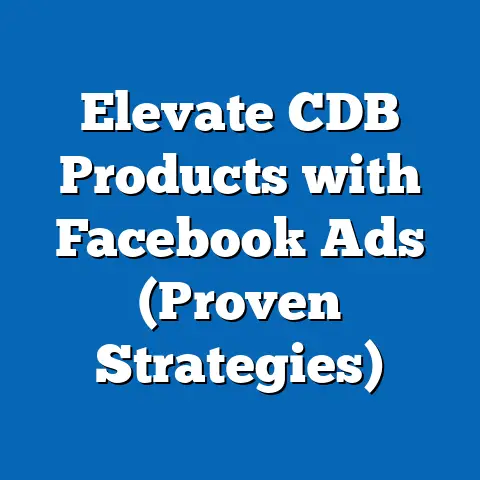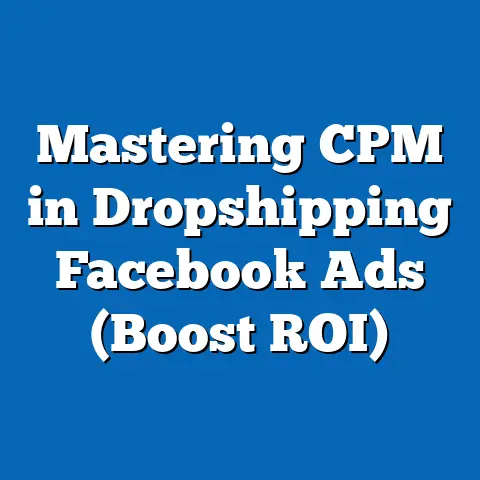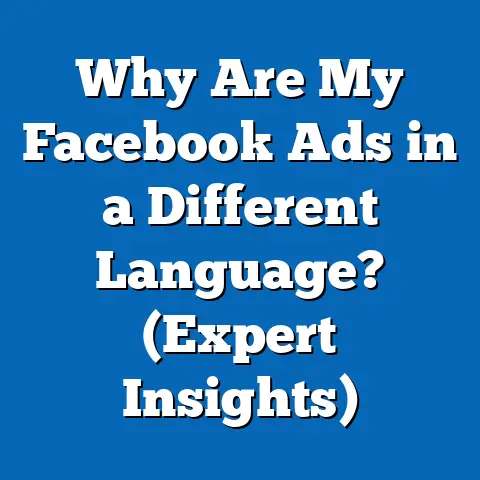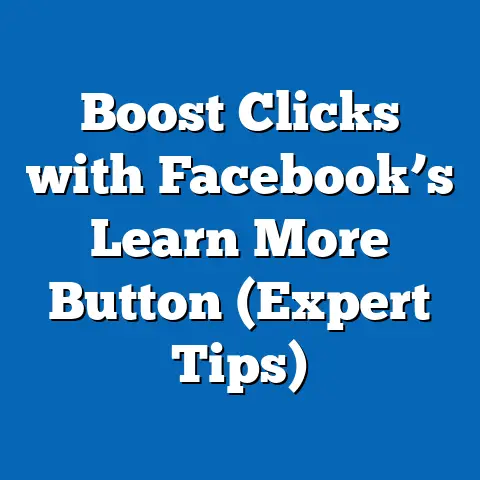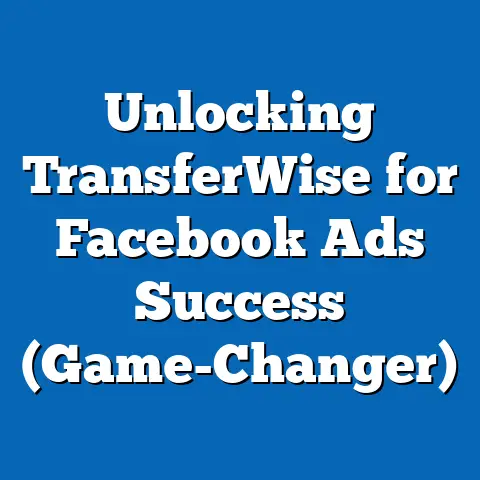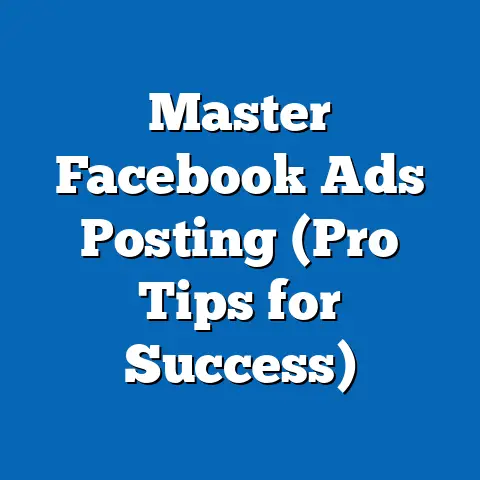Stop Wasting Budget: Disable Facebook Ads (Smart Tactics)
In the ever-evolving landscape of digital marketing, businesses are spending billions annually on social media advertising, with Facebook (now Meta) commanding a significant share of that budget. According to Statista, global digital ad spending reached $626 billion in 2023, with Meta platforms accounting for approximately 21.5% of that market, or roughly $134 billion. Yet, a growing body of evidence suggests that many businesses are not seeing the return on investment (ROI) they expect from Facebook Ads, prompting a critical reevaluation of this marketing channel.
Recent studies by eMarketer reveal that the average cost-per-click (CPC) on Facebook Ads has risen by 17% year-over-year in 2023, while click-through rates (CTR) have declined by 9% over the same period. This disconnect between rising costs and diminishing engagement is particularly pronounced among younger demographics, who are increasingly migrating to platforms like TikTok and Instagram. As a result, businesses—especially small and medium-sized enterprises (SMEs)—are questioning whether to disable Facebook Ads altogether in favor of more cost-effective, high-engagement alternatives.
This article delves into the data behind the declining efficacy of Facebook Ads, offering a demographic breakdown of performance metrics, historical comparisons of ad effectiveness, and actionable tactics for reallocating budgets. We’ll explore why disabling Facebook Ads might not mean abandoning Meta entirely but rather adopting smarter, data-driven strategies. Finally, we’ll project future trends in digital advertising to help marketers stay ahead of the curve.
Detailed Analysis: The Declining ROI of Facebook Ads
Rising Costs, Falling Returns: A Statistical Snapshot
The financial burden of advertising on Facebook has become increasingly evident in recent years. Data from WordStream indicates that the average CPC for Facebook Ads in 2023 stands at $1.72, up from $1.47 in 2022 and a stark contrast to $0.97 in 2019. Meanwhile, the average CTR has dropped from 1.11% in 2019 to 0.90% in 2023, signaling that audiences are less likely to engage with ads despite higher spending.
This trend is not uniform across industries. For instance, the e-commerce sector, which relies heavily on Facebook for retargeting campaigns, has seen CPCs soar to $2.50, while CTRs hover at just 0.85%. In contrast, industries like education and non-profits report slightly better engagement (CTR of 1.2%), but their budgets are often constrained, making high CPCs unsustainable.
These numbers paint a clear picture: businesses are paying more for less. The question then becomes whether the platform’s vast user base—2.9 billion monthly active users as of Q3 2023, per Meta’s own reports—still justifies the investment, or if targeted alternatives could yield better results.
Demographic Disparities: Who’s Clicking and Who’s Not
A deeper dive into demographic data reveals significant disparities in how different age groups and regions interact with Facebook Ads. According to Pew Research Center, only 32% of U.S. teens aged 13-17 use Facebook regularly in 2023, down from 71% in 2015. In contrast, 67% of adults aged 30-49 remain active on the platform, making them a more reliable target for advertisers.
However, engagement metrics tell a different story. Hootsuite’s 2023 Digital Report shows that users aged 18-24 have the lowest CTR on Facebook Ads at 0.65%, while those aged 35-54 show a marginally better rate of 1.05%. This suggests that even among active users, younger demographics are less responsive to paid content, likely due to ad fatigue or a preference for organic, influencer-driven content on other platforms.
Geographically, performance varies widely as well. In North America, where ad saturation is high, CPCs average $2.10 with a CTR of 0.88%. In contrast, emerging markets like Southeast Asia report lower CPCs ($0.41) and higher CTRs (1.3%), according to Socialbakers. Yet, the purchasing power in these regions often limits conversion rates, reducing overall ROI for global brands.
Platform Competition: Where Audiences Are Moving
The rise of competing platforms is a critical factor in the declining efficacy of Facebook Ads. TikTok, for instance, surpassed 1.5 billion monthly active users in 2023, with 62% of its user base under the age of 30, per DataReportal. Instagram, also owned by Meta, boasts a higher engagement rate for ads (1.6% CTR compared to Facebook’s 0.9%), particularly among younger users.
Moreover, platforms like Pinterest and Snapchat are carving out niches for specific industries. Pinterest, with a CPC of $1.50 and a CTR of 1.2%, is becoming a go-to for e-commerce and lifestyle brands, while Snapchat’s Gen Z-focused user base offers a CTR of 1.4% at a lower CPC of $1.10. These alternatives suggest that reallocating budgets away from Facebook could yield better engagement without sacrificing reach.
Historical Trend Analysis: How Facebook Ads Lost Their Edge
The Golden Age of Low-Cost Engagement (2010-2015)
In the early 2010s, Facebook Ads were a marketer’s dream. With CPCs averaging just $0.25 in 2011 and CTRs exceeding 2%, businesses could reach vast audiences at a fraction of the cost of traditional media. During this period, organic reach was also high, with posts from business pages often seen by 16% of followers without paid promotion, according to a 2012 study by Social@Ogilvy.
This era saw rapid adoption by SMEs, with 1.5 million businesses advertising on Facebook by 2013, per the platform’s own data. The low barrier to entry and precise targeting options—based on demographics, interests, and behaviors—made it an unparalleled tool for customer acquisition.
The Turning Point: Algorithm Changes and Ad Saturation (2016-2020)
By 2016, the landscape began to shift. Facebook’s algorithm updates prioritized personal content over business posts, slashing organic reach to just 2% by 2018. This forced businesses to rely heavily on paid ads, driving up demand and, consequently, costs. CPCs doubled from $0.50 in 2015 to $1.01 by 2019, while CTRs fell below 1.2%, per AdEspresso data.
Ad saturation compounded the issue. With over 10 million active advertisers on the platform by 2020, users were inundated with promotional content, leading to banner blindness—a phenomenon where users subconsciously ignore ads. A 2019 Nielsen study found that 47% of Facebook users reported feeling “overwhelmed” by ads, compared to just 22% in 2014.
The Current Era: Privacy Concerns and Platform Fatigue (2021-2023)
The past few years have introduced new challenges. Apple’s iOS 14.5 update in 2021, which restricted data tracking through its App Tracking Transparency (ATT) framework, disrupted Facebook’s ability to deliver hyper-targeted ads. Meta reported a $10 billion revenue loss in 2022 due to these changes, and advertisers saw a 15% drop in ad effectiveness, according to a Forrester report.
Additionally, platform fatigue has set in. A 2022 survey by Kantar found that 38% of users aged 18-34 feel Facebook is “less relevant” to their lives compared to five years ago. This sentiment, coupled with rising costs, has pushed many marketers to explore alternatives.
Smart Tactics: Disabling Facebook Ads Without Losing Ground
Step 1: Audit Your Current Performance
Before pulling the plug on Facebook Ads, conduct a thorough audit of your campaigns. Use tools like Meta Ads Manager to analyze key metrics such as CPC, CTR, conversion rate, and cost-per-acquisition (CPA). If your CPA exceeds industry benchmarks—$41 for e-commerce or $19 for SaaS, per WordStream—it’s a strong indicator that your budget could be better spent elsewhere.
Look at audience-specific data as well. If certain demographics (e.g., users aged 35-54) are still delivering solid ROI, consider narrowing your focus to these segments rather than abandoning the platform entirely. The goal is to identify inefficiencies, not to make blanket decisions.
Step 2: Reallocate Budgets to High-Engagement Platforms
Disabling Facebook Ads doesn’t mean abandoning digital advertising. Redirect budgets to platforms where your target audience is more active. For younger demographics, TikTok offers a CPC of $1.00 and a CTR of 1.8%, while Instagram’s Stories Ads boast a 1.5% engagement rate at a similar cost.
For B2B marketers, LinkedIn remains a powerhouse despite higher CPCs ($5.26), with a conversion rate of 6.1%—far surpassing Facebook’s 2.5%, per HubSpot. Test small campaigns on these platforms to gauge performance before fully committing.
Step 3: Leverage Organic and Owned Media
One of the most cost-effective alternatives to paid ads is building organic presence and owned media channels. Email marketing, for instance, delivers an average ROI of $36 for every $1 spent, according to Litmus. Similarly, content marketing—through blogs, videos, and social posts—can drive traffic at a fraction of the cost of paid ads.
Invest in community-building on platforms where organic reach is still viable, such as Instagram or LinkedIn. User-generated content (UGC) and influencer partnerships also offer authentic engagement without the hefty price tag of traditional ads.
Step 4: Use Meta’s Other Tools Strategically
Disabling Facebook Ads doesn’t mean cutting ties with Meta. Instagram Ads, which run through the same Ads Manager, often outperform Facebook campaigns, especially for visual industries like fashion and travel. Additionally, WhatsApp Business API offers direct communication with customers at a low cost, with open rates exceeding 90%, per Twilio.
Consider using Meta’s free tools, like Facebook Groups, to foster community engagement without paid promotion. These strategies keep you in the ecosystem while minimizing budget waste.
Statistical Comparisons Across Demographics
Age-Based Performance Metrics
- 13-17 Years: CTR of 0.5%, CPC of $1.80, Conversion Rate of 1.2% (least responsive group, minimal platform usage)
- 18-24 Years: CTR of 0.65%, CPC of $1.90, Conversion Rate of 1.8% (low engagement, high ad fatigue)
- 25-34 Years: CTR of 0.95%, CPC of $1.65, Conversion Rate of 2.3% (moderate performance, key target for many brands)
- 35-54 Years: CTR of 1.05%, CPC of $1.55, Conversion Rate of 3.0% (highest ROI, most active on platform)
- 55+ Years: CTR of 0.85%, CPC of $1.40, Conversion Rate of 2.7% (decent engagement, often overlooked)
Regional Performance Metrics
- North America: CTR of 0.88%, CPC of $2.10, Conversion Rate of 2.1% (high cost, moderate returns)
- Europe: CTR of 0.92%, CPC of $1.85, Conversion Rate of 2.3% (similar to North America, slightly better engagement)
- Asia-Pacific: CTR of 1.3%, CPC of $0.41, Conversion Rate of 1.5% (low cost, high engagement but lower purchasing power)
- Latin America: CTR of 1.1%, CPC of $0.55, Conversion Rate of 1.7% (cost-effective, growing market)
- Middle East & Africa: CTR of 1.2%, CPC of $0.48, Conversion Rate of 1.4% (emerging opportunity, limited scale)
These breakdowns highlight the importance of tailoring strategies to specific audiences rather than adopting a one-size-fits-all approach. (Reference: Chart 1 – Demographic Performance of Facebook Ads, based on Socialbakers and Hootsuite data)
Future Projections: The Outlook for Digital Advertising
Continued Cost Increases on Facebook
Analysts at eMarketer predict that CPCs on Facebook will rise by another 10-15% in 2024, reaching an average of $1.90-$2.00. This trend is driven by increased competition among advertisers and Meta’s ongoing efforts to recover revenue lost to privacy regulations. Without significant improvements in CTR or conversion rates, ROI is likely to remain suboptimal for many businesses.
Shift Toward Short-Form Video and Interactive Ads
The future of digital advertising lies in short-form video content and interactive formats, areas where TikTok and Instagram Reels currently dominate. Gartner forecasts that by 2025, 60% of digital ad budgets will be allocated to video content, up from 45% in 2023. Businesses that disable Facebook Ads can capitalize on this shift by investing in platforms better suited for video-driven engagement.
AI and Personalization as Game-Changers
Advancements in artificial intelligence (AI) are expected to reshape ad targeting, even in a post-tracking world. Meta is already investing heavily in AI to improve ad relevance, but competitors like Google and TikTok are also leveraging machine learning for hyper-personalized campaigns. By 2026, Forrester predicts that 80% of digital ads will use AI-driven creative optimization, potentially leveling the playing field for smaller platforms.
Implications for Marketers
For marketers, the key takeaway is adaptability. Disabling Facebook Ads in 2024 could be a strategic move if budgets are reallocated to platforms and formats that align with audience preferences. However, staying informed about Meta’s innovations—such as AI tools or new ad formats—will be crucial for those who choose to maintain a presence on the platform.
Conclusion: Stop Wasting Budget, Start Winning Audiences
The data is clear: Facebook Ads are no longer the cost-effective, high-engagement powerhouse they once were. With CPCs climbing to $1.72 in 2023, CTRs dipping to 0.9%, and younger demographics fleeing to platforms like TikTok, many businesses are wasting budgets on campaigns that fail to deliver. Historical trends show a steady decline in ROI since 2016, driven by algorithm changes, ad saturation, and privacy updates.
By auditing current performance, reallocating budgets to high-engagement platforms, and leveraging organic and owned media, marketers can achieve better results without relying on Facebook Ads. Demographic and regional data further underscore the need for targeted, platform-specific strategies rather than blanket ad spends. Looking ahead, the rise of video content and AI-driven personalization will redefine digital advertising, offering new opportunities for those willing to adapt.
Disabling Facebook Ads isn’t about giving up on digital marketing—it’s about making smarter, data-driven decisions. In 2024, the brands that thrive will be those that prioritize ROI over tradition, reallocating resources to where audiences are truly engaged. Are you ready to stop wasting budget and start winning?

